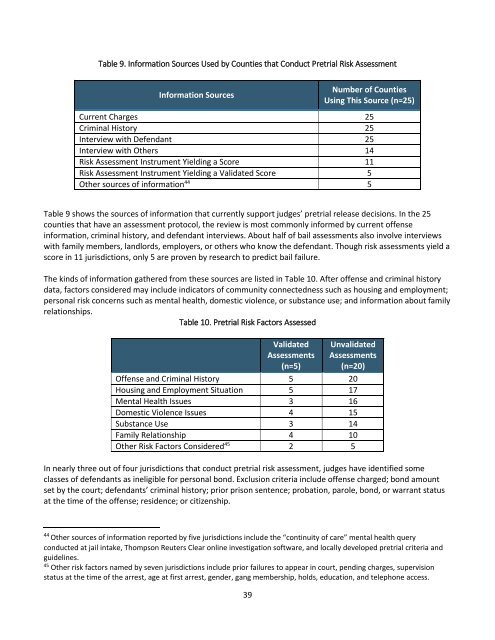LIBERTY AND JUSTICE PRETRIAL PRACTICES IN TEXAS
170308_bond-study-report
170308_bond-study-report
Create successful ePaper yourself
Turn your PDF publications into a flip-book with our unique Google optimized e-Paper software.
Table 9. Information Sources Used by Counties that Conduct Pretrial Risk Assessment<br />
Information Sources<br />
Number of Counties<br />
Using This Source (n=25)<br />
Current Charges 25<br />
Criminal History 25<br />
Interview with Defendant 25<br />
Interview with Others 14<br />
Risk Assessment Instrument Yielding a Score 11<br />
Risk Assessment Instrument Yielding a Validated Score 5<br />
Other sources of information 44 5<br />
Table 9 shows the sources of information that currently support judges’ pretrial release decisions. In the 25<br />
counties that have an assessment protocol, the review is most commonly informed by current offense<br />
information, criminal history, and defendant interviews. About half of bail assessments also involve interviews<br />
with family members, landlords, employers, or others who know the defendant. Though risk assessments yield a<br />
score in 11 jurisdictions, only 5 are proven by research to predict bail failure.<br />
The kinds of information gathered from these sources are listed in Table 10. After offense and criminal history<br />
data, factors considered may include indicators of community connectedness such as housing and employment;<br />
personal risk concerns such as mental health, domestic violence, or substance use; and information about family<br />
relationships.<br />
Table 10. Pretrial Risk Factors Assessed<br />
Validated<br />
Assessments<br />
(n=5)<br />
Unvalidated<br />
Assessments<br />
(n=20)<br />
Offense and Criminal History 5 20<br />
Housing and Employment Situation 5 17<br />
Mental Health Issues 3 16<br />
Domestic Violence Issues 4 15<br />
Substance Use 3 14<br />
Family Relationship 4 10<br />
Other Risk Factors Considered 45 2 5<br />
In nearly three out of four jurisdictions that conduct pretrial risk assessment, judges have identified some<br />
classes of defendants as ineligible for personal bond. Exclusion criteria include offense charged; bond amount<br />
set by the court; defendants’ criminal history; prior prison sentence; probation, parole, bond, or warrant status<br />
at the time of the offense; residence; or citizenship.<br />
44<br />
Other sources of information reported by five jurisdictions include the “continuity of care” mental health query<br />
conducted at jail intake, Thompson Reuters Clear online investigation software, and locally developed pretrial criteria and<br />
guidelines.<br />
45<br />
Other risk factors named by seven jurisdictions include prior failures to appear in court, pending charges, supervision<br />
status at the time of the arrest, age at first arrest, gender, gang membership, holds, education, and telephone access.<br />
39


